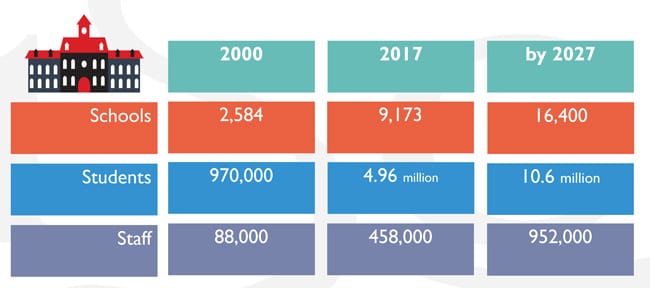International school students considering a wider range of study abroad destinations
Two reports about to be released by ISC Research highlight that an increasing number of families from non-English-speaking countries are selecting education for their children in the language of English from the very earliest age to increase their success through higher education. Coupled with this, many parents throughout Asia are choosing Western-style schools that study towards Western qualifications for their children to prepare them well for university in the West.
Wealth and aspiration fuelling demand
The ISC Research 2018 Global Report on the world’s international schools market, published this month, will show that the number of schools delivering learning in the language of English (English-medium) and following an international curriculum has grown by 29% from September 2013 to September 2017 (and a staggering 255% since the year 2000). Even more significant is the number of students attending these schools which has increased by 33% over the same period (406% in the last 17 years). There are two reasons for this.
Firstly, “Globalisation has provided the stimulus for much of the development in the international schools market,” notes the report. “Massive investment by Western businesses, especially in Asian economies, has resulted in substantial growth in the number of highly skilled and well-paid expatriates. As a consequence, there has been a large rise in demand for international schooling from expatriate communities.”
Secondly, the report adds, “The rapid growth of many economies, especially in Asia, has generated a vast increase in the amount of individual wealth among local families in those countries. For example, 2017 reports suggest that there are around 1.6 million USD millionaires and nearly 650 USD billionaires residing in China. Many families have high aspirations for their children and want them to receive the best education, which usually means enrolling them abroad for their schooling or at international schools in their home countries, followed by undergraduate studies at Western universities. The scale of the increase in individual wealth has resulted in a dramatic increase in the number of local families who can afford international school tuition fees, leading to a comparable increase in demand for places at international schools.”

The route to higher education
A second report, due to be published in March, studies the pathway from international schools to higher education. The report draws on a survey of the college counsellors of 306 international schools around the world to collect data and intelligence on the qualifications achieved and the higher education destination choices of Grade 12 international school students. American, British, and International Baccalaureate curriculum and examinations are recognised by the majority of universities around the world and they dominate the international schools market. Nearly half (45%) of all international schools follow British curriculum and/or study towards A levels, with the balance following an American-style of curriculum and/or study towards Advanced Placement, or the International Baccalaureate programmes and work towards the IB Diploma.
The high rate of academic success
According to the new ISC Higher Education Report, students at English-medium international schools achieve, on average, higher grades compared to the global average. Of the schools studied, the average points achieved by students in international schools in the IB Diploma was 33.2 compared to a global average in 2017 of 29.95. For Advanced Placement, examination scores greater than 3 by students in international schools was 76%, compared to 57.9% worldwide. And for A Levels, the percentage of international school students achieving A or A* grades was 30.6%, compared to a UK average of 25.8%. It's not surprising then that 91% of international schools studied by ISC Research say that over 90% of their students pursue higher education.
Degree choices are far and wide
The results from the ISC Higher Education Report show the breadth of undergraduate degree subjects, countries and universities that international school students consider. Unlike many international students who know of and seek out the high profile courses and colleges in the most obvious countries, students attending the English-medium, Western-influenced international K-12 schools appear more informed of the wide range of undergraduate options that are available to them. This seems to be due to the direct and impartial support of college counsellors employed by many international schools to guide students to the best solutions for their individual needs. It’s also considered to be due to the diverse international demographics of the students and staff at these schools which open eyes and minds to possibilities the world over. The research suggests that English-medium international school students are no longer just looking at the UK or US for their higher education destinations. Canada, Australia and non-English-speaking countries where English-medium undergraduate degree courses are now being offered, such as in the Netherlands and the UAE, are all serious contenders in the destination choice. Within the top 50 universities where Grade 12 international school students from the 2015/16 year achieved places, several higher education establishments in Hong Kong, South Africa, the Netherlands, UAE, Mexico, and Colombia were included as well as those in the US, UK, Australia, and Canada. International school students demonstrate an increasingly measured selection criteria for their undergraduate degrees. No longer do they simply aspire to an Ivy League or British Redbrick university just because that’s what people have done in the past. Today, they are more discerning about their choice and this takes into consideration many factors, from cost, location, quality of education and subject focus, to political implications, visa challenges, scholarship potential, and subject flexibility. This suggests that the traditional destination universities in the UK and US should sit up and take note. There’s much more to university selection than country and brand today. Diane Glass is Commercial Director at ISC Research. ISC provides an online market information and communication tool for international undergraduate recruitment and marketing targeting the international schools sector. The Pathway to Higher Education Report from ISC Research includes examination results, country and university destinations, undergraduate subject choices, and the perceived benefits and barriers to studying in key destination countries. Please see the ISC website for additional information or contact Diane directly to obtain a copy of the report.














